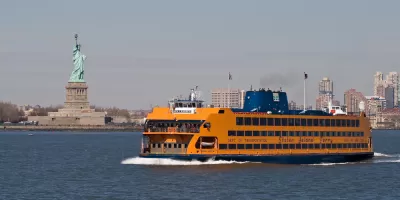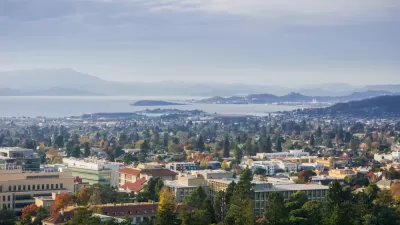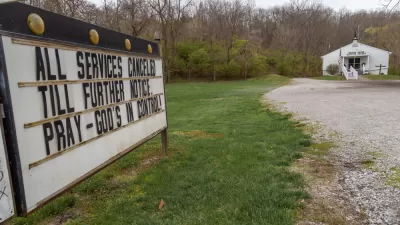Governors of three of the nation's largest states, containing the three largest cities, have issued emergency orders to slow the spread of COVID-19.

Updated March 21: Govs. Ned Lamont of Connecticut and Tom Wolf of Pennsylvania issued shutdown orders on Friday. On Saturday, New Jersey Gov. Phil Murphy issued a Stay at Home Order, closing all non-essential retail businesses effective at 9 p.m.
The dire orders by the three Democratic governors, Newsom (Calif.) on Thursday and by Cuomo (N.Y.) and Pritzker (Ill.) on Friday "come as Anthony S. Fauci, director of the National Institute of Allergy and Infectious Diseases, said Friday that Americans will need to stay at home as much as possible and maintain social distance from other people for at least several weeks to stem the spread of the virus," according to the Washington Post.
In his "must-see TV" daily coronavirus press briefing on Friday morning, Cuomo announced his PAUSE Executive Order, a 10-Point "Policy that Assures Uniform Safety for Everyone," with the first one being:
- Effective at 8 PM on Sunday, March 22, all non-essential businesses statewide will be closed;
A majority of the points ingrain social distancing behavior:
- Any concentration of individuals outside their home must be limited to workers providing essential services and social distancing should be practiced;
- When in public individuals must practice social distancing of at least six feet from others;
- Businesses and entities that provide other essential services must implement rules that help facilitate social distancing of at least six feet;
- Individuals should limit use of public transportation to when absolutely necessary and should limit potential exposure by spacing out at least six feet from other riders;
- Young people should also practice social distancing and avoid contact with vulnerable populations
In addition, it includes "Matilda's Law," named for his mother, which provides protections for 70+ year seniors and other "vulnerable populations." This may be the first COVID-19 directive that requires a portion of the population to wear masks and not to use public transit. This population is directed to:
- Wear a mask when in the company of others;
- Not take public transportation unless urgent and absolutely necessary.
And to "the greatest extent possible, everyone in the presence of vulnerable people should wear a mask."
“No, this is not life as usual,” Cuomo said as the death toll in the U.S. topped 200 on Friday, with at least 35 in his state, notes an AP article on the orders issued by the three governors. “Accept it and realize it and deal with it.”
Illinois
"To avoid the loss of potentially tens of thousands of lives, we must enact an immediate stay-at-home order for the state of Illinois," Gov. J.B. Pritzker said at a press conference, reported BuzzFeed.
"I fully recognize I am choosing between saving people's lives and saving people's livelihoods," Pritzker said, "but ultimately you can't have a livelihood if you don't have a life."
The governor issued a Disaster Proclamation that used California Gov. Newsom's term, "stay at home" or place of residence in his executive order [pdf]. "Pritzker said his latest decision was based on conversations with 'some of the best medical experts, epidemiologists, mathematicians and modelers,'" reported the Chicago Times. It took effect Saturday at 5 p.m. and continues "through at least April 7."
In short, residents who have heeded calls to work from home, maintain a social distance and repeatedly wash their hands will have no problem adjusting to the governor’s latest directive.
“For the vast majority of you already taking precautions, your lives will not change very much,” Pritzker said of the shelter-in-place directive.
The village of Oak Park outside Chicago had already issued at shelter-in-place order that took effect Friday.
Related in Planetizen:
-
The New Regionalism of the Coronavirus Pandemic, March 19, 2020
FULL STORY: Coronavirus stay-home orders apply to one in five Americans as confirmed cases are expected to skyrocket

Study: Maui’s Plan to Convert Vacation Rentals to Long-Term Housing Could Cause Nearly $1 Billion Economic Loss
The plan would reduce visitor accommodation by 25,% resulting in 1,900 jobs lost.

North Texas Transit Leaders Tout Benefits of TOD for Growing Region
At a summit focused on transit-oriented development, policymakers discussed how North Texas’ expanded light rail system can serve as a tool for economic growth.

Why Should We Subsidize Public Transportation?
Many public transit agencies face financial stress due to rising costs, declining fare revenue, and declining subsidies. Transit advocates must provide a strong business case for increasing public transit funding.

How to Make US Trains Faster
Changes to boarding platforms and a switch to electric trains could improve U.S. passenger rail service without the added cost of high-speed rail.

Columbia’s Revitalized ‘Loop’ Is a Hub for Local Entrepreneurs
A focus on small businesses is helping a commercial corridor in Columbia, Missouri thrive.

Invasive Insect Threatens Minnesota’s Ash Forests
The Emerald Ash Borer is a rapidly spreading invasive pest threatening Minnesota’s ash trees, and homeowners are encouraged to plant diverse replacement species, avoid moving ash firewood, and monitor for signs of infestation.
Urban Design for Planners 1: Software Tools
This six-course series explores essential urban design concepts using open source software and equips planners with the tools they need to participate fully in the urban design process.
Planning for Universal Design
Learn the tools for implementing Universal Design in planning regulations.
City of Santa Clarita
Ascent Environmental
Institute for Housing and Urban Development Studies (IHS)
City of Grandview
Harvard GSD Executive Education
Toledo-Lucas County Plan Commissions
Salt Lake City
NYU Wagner Graduate School of Public Service





























